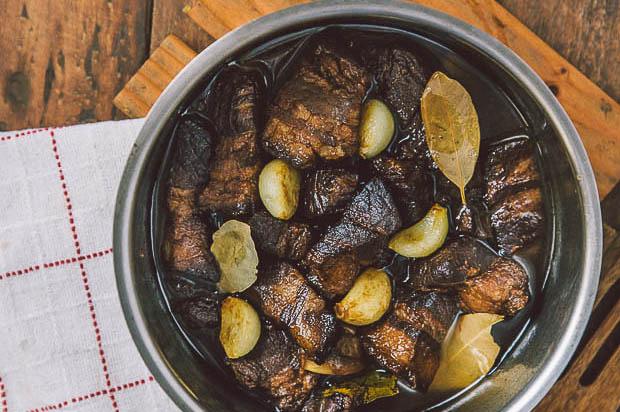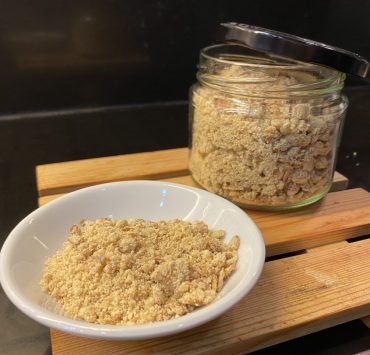Adobo is easily the most recognizable Filipino dish. Every Pinoy knows how to cook it or at least what should go in it. There needs to be soy sauce, vinegar, meat (pork or chicken), and spices (garlic, onion, pepper, laurel leaves)—at least that’s what I grew up knowing from the comfort of our mostly Tagalog kitchen.
[RECIPE: How to cook the ultimate traditional adobo]Somewhere else in the Philippines someone cooks adobo differently but it doesn’t make it any less of an adobo. They may skip toyo and use just suka (which by itself has many varieties all over the archipelago). Some will be sourer than others, some will swim in a soupy stew while others will look dry. And some of these cooks will be mad upon hearing that a Department of Trade and Industry (DTI) technical committee plans to standardize adobo, as in distilling this dish of many influences and varieties into a uniform recipe that results in a single recognizable and replicable dish.
‘How can we say that this is the basic Philippine adobo?’
According to DTI’s website, the Bureau of Philippine Standards (DTI-BPS) has established BPS/TC 92 that will develop the Philippine National Standards (PNS) on popular Filipino dishes, taking into consideration the variations in cooking techniques observed in all regions of the country.
We are actually talking about this standardization belatedly as the bureau had already started developing a PNS for adobo as early as May this year. The committee referenced the 2008 book “Kulinarya: A Guidebook to Philippine Cuisine,” co-written by BPS/TC 92’s chairperson Glenda Barreto and vice-chairperson Myrna Segismundo along with other notable Filipino chefs and food writers.
Consulting with other prominent figures in the local food scene as well as local food manufacturing stakeholders, chefs, food writers, media, and the academe, they will set out to “benchmark the cooking technique for Philippine adobo [to] help preserve the country’s cultural identity despite the variations made to it.” (Adobo is technically a way of cooking and not a dish, said BPS/TC 92’s vice-chairperson chef Raoul Roberto Goco.)
The committee’s guiding question? “How can we say that this is the basic Philippine adobo?”
Two sides of the table
This move, of course, was met with criticism both from ordinary adobo-loving Filipinos to chefs and restaurateurs that the committee is trying to woo.
As early as June, chef Jam Melchor, founder of the Philippine Culinary Heritage Movement has sounded the alarm on this proposal. Last week, he broke his silence as news about the committee became official.
In a Facebook post, Melchor defended the diversity of our cuisine, which he considers its strength. He added that there are many other effective approaches or measures to promote our cuisine and local food culture that the committee can explore. “As a staunch advocate of Filipino cuisine, this is my stand: Standardization is NOT the answer at this point.”
Food historian and writer Felice Prudente Sta. Maria also took to social media to air her stand on the matter, posting a comic strip of two inmates, one asking the other what they got arrested for. The man answers, “Mali luto ko ng adobo.” (I cooked adobo wrong.)
Yesterday, DTI put out another statement regarding the committee’s goal. It clarified that there is nothing to worry about and that the move is really targeted for international promotions, adding that it is not a mandatory standard.
“There was a suggestion in the industry to have consultations among chefs and what will be in a TRADITIONAL recipe especially for international promotions,” the statement read. “[For] example, your adobo won’t become paksiw or humba or your menudo won’t become afritada. Or we heard there’s also adobo from Mexico. Again, this is for promotion abroad.”
Some chefs and food personalities back this in the interest of promoting our cuisine to the world. Some cite Thailand’s National Food Institute, Ministry of Industry’s success in standardizing its pad thai, curries, and stews, which begun in 2017.
The project, which was called “The Authentic Thai Food for the World”, set out to develop a taste test system that offers a single standard of taste in line with original recipes, therefore resolving taste disparities in Thai food found all over the world.
It recognized and incentivized participating food businesses (restaurants, manufacturers, etc.) by endorsing their dishes and products with an “Authentic Thai” certification.
Can this standardization project do wonders for our cuisine in its way to global recognition?
Adobo is just the tip of the proverbial iceberg. Next on BPS/TC 92’s agenda: sinigang, lechon, and sisig.




